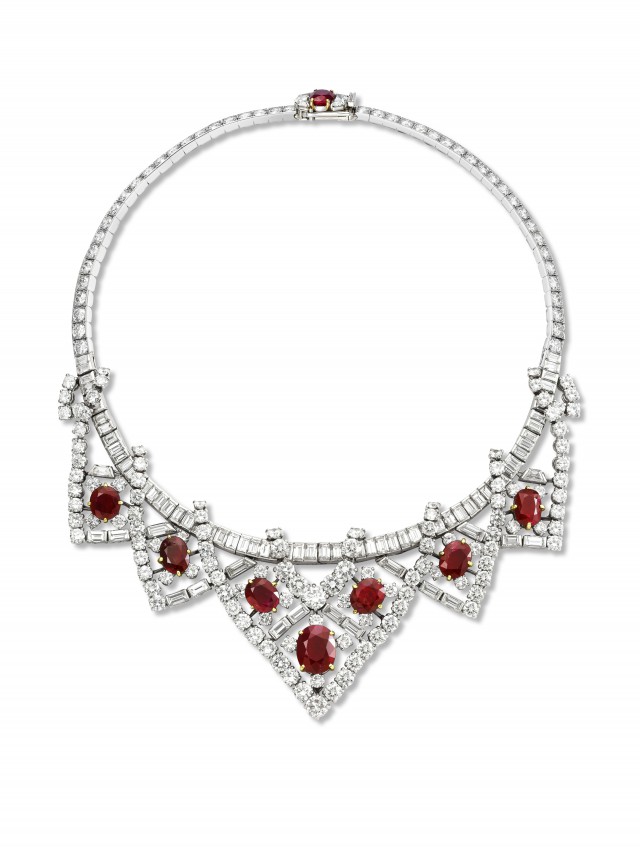
The story of Cartier jewelry is one that’s less about objects and opulence than it is one about wearers and workers — the jewelry makers, that is, and the people who went on to adorn themselves with the pieces made. As much as the Denver Art Museum’s Brilliant: Cartier in the 20th Century is a showcase of stunning and elegant jewelry, it is also a tour of the history and influences of the time. The survey begins at 1900 with three savvy brothers, Louis, Pierre and Jacques Cartier, who vowed to become the greatest in the profession they inherited from their grandfather, Cartier founder Louis-François Cartier, and ends in the 1970s. Along the way, Brilliant also illuminates a century of a greatly changing world. Women’s liberation showed in their fashions, their choices to smoke — and subsequently, in the necklaces made to better match flappers’ dropped-waist dresses and women’s cigarette holders. Early threads of globalization that now enable us to speak with someone in Tokyo as easily as someone across town are apparent in jewelry and vanity cases and clocks that draw from art and artifacts from India, Egypt and Japan. Historical notes are marked — didn’t quite lose all your cash in 1929? You’ll spend the 1930s attending parties meant to craft a sense of exotic foreign places and fairy tale forgetfulness, like the playful indulgence of the “tutti-fruitti” designs from Cartier. Coronations of kings are noted in the lingering presence of tiaras, a required accessory for female attendees. A decade of economic depression eventually shows in an increased presence in other, more affordable gemstones — aquamarine, peridot and citrine, though they’re often the size of silver dollars.
“As soon as you deal with objects like jewels, particularly gorgeous jewels, you immediately deal with history, with people, with the magic components that I think stones always have for all cultures — gold and stones always had — and of course all these layers of status, of power. Jewelry, if you go back, is as old as humankind,” says Christoph Heinrich, director of the Denver Art Museum. “There is engrained in our DNA this wish to elevate ourselves, to show our status with jewelry and a lot of reflection material for that is in this wonderful show Brilliant: Cartier in the 20th Century.”
The intertwining of wearable art and changes in the world is a necessary intertwining. Jewelry reflects how we feel, what we want to say to the world. Unlike an avant-garde painting you could hang in your bedroom and deny ever owning lest it embarrass you to your friends, your jewelry can’t be kept secret. It’s not a private enjoyment, but a public statement.
“A jewel is a declaration of faith,” Pierre Rainero, image, style and heritage director for Cartier International writes in the introduction to the exhibition catalog. “This is not only because the creation of its sublime materials is shrouded in mystery but also because we offer jewelry and accept it out of love. We wear it as a message, a declaration, an offering, a talisman.”
What wearers of Cartier’s jewelry, which was some of the most soughtafter by the European aristocracy and American bourgeoisie, would broadcast with it was a search for refinement and authenticity, a welcoming of innovation and an embrace of beauty.
Margaret Young-Sánchez, curator of the exhibit and of Pre-Columbian art for the Denver Art Museum, divided the exhibition into sections that group by history with thematic flourishes to draw themes out, like the influence of Asian art, the presence of smoking and the accoutrement that accompanies it and the often-overlooked niche of men’s items, including clocks, wrist and pocket watches, cufflinks and even tokens of aviation and space achievements, such as a gold model of the lunar excursion module.
“It’s not just beautiful objects, but how cultural norms changed,” Young- Sánchez says.
The finale is spent with female icons of style — five women known for wearing the jewelry. But don’t overlook the mention to the so-called “panther,” the thoroughly modern woman Jeanne Toussaint, who became a Cartier designer in the 1920s and director of fine jewelry for Cartier in 1933, where her influence carried until 1970. She was noted for a confident, feminine approach to fine jewelry that was groundbreaking at the time, according to Rainero, and is credited with familiar motifs, including the floral and animal themes, and a humor and whimsy that was particularly called upon during challenging economic times. When Cartier bent with the changing gender roles, it was Toussaint, a modern woman herself, who’s hand applied the pressure to adapt.
Those five icons were heiress and fashion icon Daisy Fellowes, Duchess of Windsor (American socialite Wallis Simpson for whom King Edward VIII abdicated the British throne), Princess Grace of Monaco, Elizabeth Taylor and Mexican movie star María Felix, each known for their beauty, fashion sense, and for leading trends.
“There is no doubt in our mind that Cartier’s style would not have been the same without the personality and the aura of these great customers,” Rainero says.
In addition to illuminating the jeweler and its wearers, Brilliant spends a portion of time with the jewelry makers, showing step by step the laborious craftsmanship required to complete delicate, ethereal pieces. In addition to showcasing the hardware that goes into jewelry-making, they unravel the design process, drawing from the Cartier heritage collection, which was started in 1983 to document how Cartier style has evolved and now totals more than 1,500 works, to showcase archived documents, photographs and plaster casts used to record pieces.
Each showcase of pieces from the heritage collection, Rainero says, offers an “insight into a glittering age.”
The hope is that visitors will emerge knowing more about the 20th century than they did going in.
Brilliant was tailor-made for Denver. It’s not a touring show. Want to see these items, many of which were gathered from private collections and are only on loan, rarely seen before and not likely to be seen much after this exhibition? This is your only chance to stare at them and hope to catch a glimpse of history and humans now half forgotten.
Respond: [email protected]














